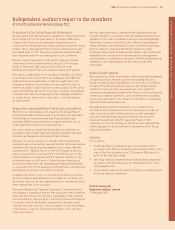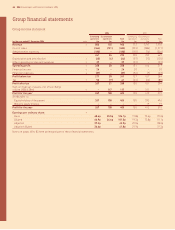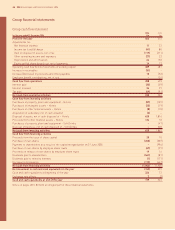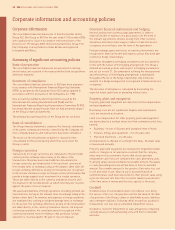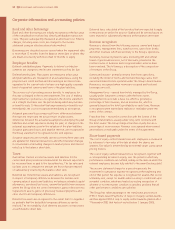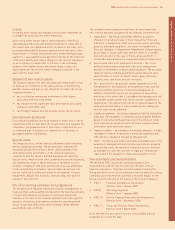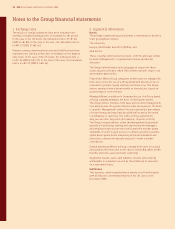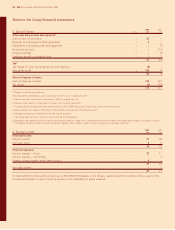Holiday Inn 2006 Annual Report Download - page 52
Download and view the complete annual report
Please find page 52 of the 2006 Holiday Inn annual report below. You can navigate through the pages in the report by either clicking on the pages listed below, or by using the keyword search tool below to find specific information within the annual report.
Corporate information and accounting policies
Bank and other borrowings
Bank and other borrowings are initially recognised at the fair value
of the consideration received less directly attributable transaction
costs. They are subsequently measured at amortised cost. Finance
charges, including issue costs, are charged to the income
statement using an effective interest rate method.
Borrowings are classified as non-current when the repayment date
is more than 12 months from the balance sheet date or where they
are drawn on a facility with more than 12 months to expiry.
Employee benefits
Defined contribution plans Payments to defined contribution
schemes are charged to the income statement as they fall due.
Defined benefit plans Plan assets are measured at fair value
and plan liabilities are measured on an actuarial basis, using the
projected unit credit method and discounting at an interest rate
equivalent to the current rate of return on a high quality corporate
bond of equivalent currency and term to the plan liabilities.
The service cost of providing pension benefits to employees for
the year is charged to the income statement. The cost of making
improvements to pensions is recognised in the income statement
on a straight line basis over the period during which any increase
in benefits vests. To the extent that improvements in benefits vest
immediately, the cost is recognised immediately as an expense.
Actuarial gains and losses may result from: differences between
the expected return and the actual return on plan assets;
differences between the actuarial assumptions underlying the plan
liabilities and actual experience during the year; or changes in the
actuarial assumptions used in the valuation of the plan liabilities.
Actuarial gains and losses, and taxation thereon, are recognised in
the Group statement of recognised income and expense.
Actuarial valuations are normally carried out every three years and
are updated for material transactions and other material changes
in circumstances (including changes in market prices and interest
rates) up to the balance sheet date.
Taxes
Current tax Current income tax assets and liabilities for the
current and prior periods are measured at the amount expected to
be recovered from or paid to the tax authorities. The tax rates and
tax laws used to compute the amount are those that are enacted
or substantively enacted by the balance sheet date.
Deferred tax Deferred tax assets and liabilities are recognised
in respect of temporary differences between the tax base and
carrying value of assets and liabilities, including accelerated capital
allowances, unrelieved tax losses, unremitted profits from overseas
where the Group does not control remittance, gains rolled over into
replacement assets, gains on previously revalued properties and
other short-term temporary differences.
Deferred tax assets are recognised to the extent that it is regarded
as probable that the deductible temporary differences can be
realised. The recoverability of all deferred tax assets is reassessed
at each balance sheet date.
Deferred tax is calculated at the tax rates that are expected to apply
in the periods in which the asset or liability will be settled, based on
rates enacted or substantively enacted at the balance sheet date.
Revenue recognition
Revenue is derived from the following sources: owned and leased
properties; management fees; franchise fees; sale of soft drinks
and other revenues which are ancillary to the Group’s operations.
Generally, revenue represents sales (excluding VAT and similar
taxes) of goods and services, net of discounts, provided in the
normal course of business and recognised when services have
been rendered. The following is a description of the composition
of revenues of the Group.
Owned and leased – primarily derived from hotel operations,
including the rental of rooms and food and beverage sales from
owned and leased hotels operated under the Group’s brand names.
Revenue is recognised when rooms are occupied and food and
beverages are sold.
Management fees – earned from hotels managed by the Group,
usually under long-term contracts with the hotel owner.
Management fees include a base fee, which is generally a
percentage of hotel revenue, and an incentive fee, which is
generally based on the hotel’s profitability or cash flows. Revenue
is recognised when earned and realised or realisable under the
terms of the contract.
Franchise fees – received in connection with the license of the
Group’s brand names, usually under long-term contracts with
the hotel owner. The Group charges franchise royalty fees as a
percentage of room revenue. Revenue is recognised when earned
and realised or realisable under the terms of the agreement.
Share-based payments
The cost of equity-settled transactions with employees is measured
by reference to fair value at the date at which the shares are
granted. Fair value is determined by an external valuer using option
pricing models.
The cost of equity-settled transactions is recognised, together with
a corresponding increase in equity, over the period in which any
performance conditions are fulfilled, ending on the date on which the
relevant employees become fully entitled to the award (vesting date).
The income statement charge for a period represents the
movement in cumulative expense recognised at the beginning and
end of that period. No expense is recognised for awards that do not
ultimately vest, except for awards where vesting is conditional upon
a market condition, which are treated as vesting irrespective of
whether or not the market condition is satisfied, provided that all
other performance conditions are satisfied.
The Group has taken advantage of the transitional provisions of
IFRS 2 ‘Share-based Payments’ in respect of equity-settled awards
and has applied IFRS 2 only to equity-settled awards granted after
7 November 2002 that had not vested before 1 January 2005.
50 IHG Annual report and financial statements 2006





